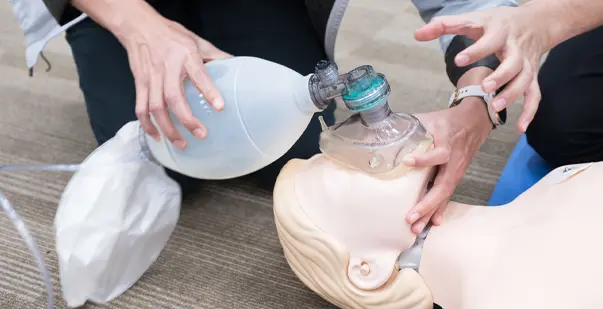Table Of Content(s)
- Bag Valve Mask Technique in BLS
- How are breaths delivered using a bag mask?
- The importance of Bag Valve Mask in emergencies
- Conclusion
In the sphere of Basic Life Support care, mastering various skills stands crucial. Gaining efficiency in providing such skills doesn’t only impact positive patient outcomes but also enhances the quality of care delivered. One such vital skill is the bag valve mask technique. This process is critical for patients who need adequate ventilation, when not breathing. It is even helpful for those who are struggling to breathe effectively. Relatively much easier than intubation, the bag valve mask technique is revolutionary and lifesaving.
Whether you are a healthcare professional or simply a potential bystander, acquiring the skills of bag valve mask technique can be life altering.
In this blog, we will explore the intricacies of Bag Valve Masks along with its importance in emergency situations. By the end of this blog, you will be confident in delivering the skills of basic life support along with bag valve mask techniques.
How are breaths delivered using a bag mask?
Delivering breaths using a bag valve mask (BVM) is a fundamental skill in emergency medical situations, particularly for individuals who are not breathing or have inadequate respiration. The BVM device allows rescuers to provide positive pressure ventilation. This ensures the patient receives necessary oxygen. Here’s a step-by-step guide on how to properly deliver breaths using a bag mask:
- Position the Patient: Ensure the patient is lying on their back on a firm surface. Open the airway using the head-tilt, chin-lift maneuver or the jaw-thrust maneuver if a spinal injury is suspected.
- Assemble the BVM: Check that the bag valve mask is properly assembled and functional. Ensure the mask fits the patient’s face snugly to prevent air leakage.
- Seal the Mask: Place the mask over the patient’s nose and mouth. Use the E-C clamp technique: form a “C” shape with your thumb and index finger to press down on the mask. Form an “E” with the other three fingers to lift the patient’s jaw, creating a tight seal.
- Deliver Breaths: Squeeze the bag gently and steadily, watching the patient’s chest rise. Each breath should last about one second. Allow the bag to refill between breaths. Deliver one breath every 5-6 seconds for adults, or every 3-5 seconds for children and infants.
- Monitor and Adjust: Continuously monitor the patient’s chest for adequate rise and fall. Adjust the mask seal or bag pressure if needed to ensure effective ventilation. Watch out for any signs of complications, such as gastric inflation or inadequate chest rise. Based on the observations, adjust your technique accordingly.
Read More: CPR Ratio for Adults, Children, and Infants
The importance of Bag Valve Mask in emergencies
The ability to provide immediate and effective ventilation can make the difference between life and death. The Bag Valve Mask (BVM) is an essential tool in the healthcare domain. Doctors, first responders, and trained bystanders, heavily rely on it to ensure the best possible treatment. Here’s why the Bag Valve Mask is so crucial in emergencies:
- Immediate Ventilation: The BVM allows for rapid delivery of oxygen to patients experiencing respiratory distress, apnea, or inadequate breathing, stabilizing their condition until advanced medical care is available.
- Non-Invasive: Unlike more invasive methods, the BVM provides a non-invasive way to maintain oxygenation and ventilation, reducing the risk of complications associated with more aggressive interventions.
- Versatility: BVMs are suitable for use on patients of all ages, from infants to adults, making them an invaluable tool in diverse emergency scenarios.
- Ease of Use: With proper training, the BVM can be effectively used by a wide range of responders, from paramedics to laypersons, ensuring that help can be provided quickly in critical situations.
- Support for CPR: During cardiopulmonary resuscitation (CPR), the BVM is essential for delivering breaths in combination with chest compressions. This significantly improves the chances of survival and recovery.
- Oxygen Enrichment: When connected to an oxygen source, the BVM can deliver high concentrations of oxygen. This is vital for patients with severe respiratory issues.
- Portability: BVMs are lightweight and portable, allowing them to be easily carried and used in a variety of settings, from ambulances to remote locations.
Read More: Decoding Epilepsy: Saving Lives with CPR
Conclusion
The bag valve mask technique is a vital attribute to basic life support. By understanding the intricacies of BVMs, individuals can successfully bridge the gap between the onset of a respiratory emergency and the arrival of advanced medical care. Providing positive pressure ventilation, bag valve masks are easy to use. But it is important to keep your education continued, to stay updated with the skills of BVM. You can learn everything about bag valve mask techniques from an accredited BLS course. So take the first step and sign up today!
